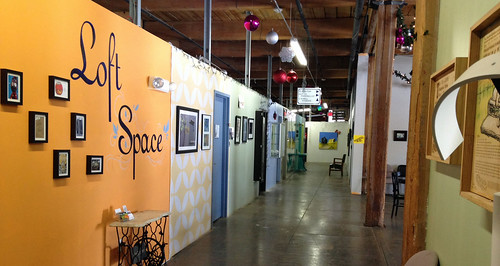“and now for something completely different” by Maxine Farkas

2nd floor of Western Ave Studios
The following is by Maxine Farkas, our correspondent at Western Avenue Studios:
I read a comment on Facebook the other day that indicated that there is a lack of knowledge about how the art world works . . . what follows is taken from a Western Avenue Studios Artist Association Vision Statement that was written in the winter of 2006/2007 by Ashlee Welz Smith, Meghan Moore and myself. There have been a lot of changes since this was written and I’ve tried to update it where I could, based on what I know about various entities. (For example, I don’t know much about the structure at UnchARTed)
Artist as Small Business – modes of operation
Traditional Gallery Representation – limited interaction with the public
Traditionally, sales of artist work happens through an art consultant or through established galleries, of which there are two kinds: commercial and non-profit. Commercial galleries, like those on Newbury Street or Harrison Ave in Boston, usually specialize in a specific type of art and represent a limited pool of artists. Non-profit galleries in Lowell – such as the 119 Gallery, The Brush, The Parker Gallery, Zeitgeist and the A.L.L. Arts Gallery – focus on rotating exhibits, which must have an educational component as a requirement of their 501(c)3 status. Non-profit galleries do not represent individual artists except for the duration of a particular exhibit. The artwork that is shown in galleries, both commercial and non-profit, is work that is perceived by the gallery director/curator to be saleable to their particular clientele or which fits a particular theme or – in some cases – both. A third outlet is the co-op gallery which charges individual artists to hang their work, some like the co-op galleries at A.L.L., Zeitgeist and the Brush rent wall space to its artists and the artists are responsible for maintaining their space while others, like the Loading Dock Gallery, are curated spaces where members bring in their work and the gallery takes the responsibility for presenting the work. Very often gallery sitting is a requirement for membership in a co-op gallery.
The way that work is shown in galleries can vary, depending on the venue. If selected for a juried show, an artist may have one or two pieces hanging with a large group of work by others. If selected for a small group show, the artist may have a selection of pieces, hanging with the work of three or four other individuals. A solo show may have up to 25 pieces depending on the size of the gallery, and an artist will often create work for a year or more for a solo show.
Another way that artists can sell their work is through an art consultant who acts as the artist’s representative. However, acceptance in a show by an art consultant or by a gallery does not insure sales. It is quite possible to work for a year to prepare for a solo show and then not sell anything. If work is sold, the artist pays a commission to the gallery or art consultant and these
commissions range from 30% to 60% of the sales price of the work.
Artists can spend up to half of their time marketing their work, sending out images and promotional materials to galleries in hopes of being chosen for representation, or answering calls for entries to juried shows. Once their work is accepted by a gallery or juried show, the artist then promotes the show in various ways, including sending out postcards, utilizing social media and contacting his or her mailing list. In the traditional gallery model, most of the direct contact with the public is made by representatives, and there is little interaction between the artist and the public except at opening receptions.
The Open Studios Alternative – direct interaction
At Western Avenue Studios, the artists open their studios to the public on the first Saturday of each month. Artists are available to talk about their work and to demonstrate how they do what they do. Individuals interested in art are able to see an artist’s entire body of work, not just work that was screened by a third party. If someone is excited by what they see, the creator of the work is right there, available to interact with the viewer. It can be an exciting experience for all involved.
Another advantage to open studios is that the work that is on display covers a broad spectrum of styles and media. There are no filters imposed by third parties between the art and the viewer. Sales are made and orders for new work are given at open studios events. And there is no commission paid on sales.
To paraphrase a current tv commercial . . . thus endeth the lesson.
Since the artists at Western Avenue Studios first decided to implement First Saturday Open Studios in the fall of 2005, we have been open to the public 125 days and close to 56,000 visitors have taken the opportunity to walk the halls, talk to the artists and learn about how art is made.
On an average First Saturday anywhere from 75 to 100 artists will open their studios. On an average First Saturday, relationships between artists and visitors begin or continue to develop. And on an average First Saturday visitors from as far away as Concord NH and Hartford CT come to experience a bit of what Lowell has to offer.